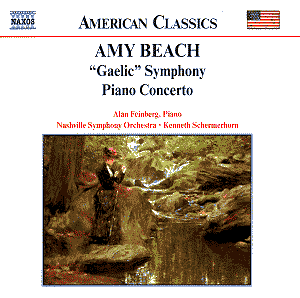How good it is to see the music of Amy Beach turning
up on a fairly regular basis these days (Chandos in particular have
issued several top-class discs). This new Naxos disc makes a logical
pairing of two major works, and yet it is unique in the catalogue.
Beach was a concert pianist by profession, but
the prevailing Zeitgeist meant that when she married, her
husband was able to dictate that she only played in public once
a year. Composition was allowed, however, and during the 25 years
of her marriage Mrs Beach composed a great deal, including the
two pieces under consideration. Indeed, Beach was soloist in the
première of her piano concerto in April 1900 in Boston.
She must have been a remarkable player, if this
concerto is anything to go by. The piece is cast in four movements
and uses some of the composer’s own songs as melodic material.
There is a romantic bent to much of this piece, a kind of distant
nostalgia that is most affecting. Some of the melodic material
comes from Beach’s own songs, perhaps aiding the lyrical core
of the piece. Indeed, the music flowers beautifully and irresistibly:
this feeling of an ongoing logic is a direct outgrowth from Beach’s
natural harmonic sensitivity. The cadenza displays heart-on-sleeve
virtuosity openly.
The second movement Scherzo is probably the most
memorable movement, though. It is a perpetuum mobile, with
the finger-breaking (and finger-twisting!) piano part remarkably
despatched here by Feinberg. An element of play is foregrounded
here that contrasts with the more serious Largo, which begins
in homage to Wagner before returning to Beach’s free-flowing ease
of composition. The sparkling finale contains gestures which more
than tend towards the Lisztian. This is a fascinating piece which,
especially at this price, is wholeheartedly recommended to the
curious.
The slightly earlier Symphony in E minor uses
four traditional Irish tunes as part of its vocabulary (this was
in response to the composer having heard the Boston Premiere of
Dvořák’s ‘New World’
Symphony). The nostalgic elements identified in the piano concerto
are here even more obvious, especially when heard as shamelessly
as in the sunnily lyrical Lento con molto espressione third movement.
It is true that the finale can be syrupy, too. In fact it is the
well-crafted first movement (the Nashville strings cope well with
the high-lying lines) and the sweet, swift-of-foot Siciliana which
seem to be the piece’s strongest statements.
The Nashville orchestra plays with all the commitment
one could desire, and Tim Handley’s recording is clear and atmospheric.
A bargain.
Colin Clarke
see also review
by Neil Horner
